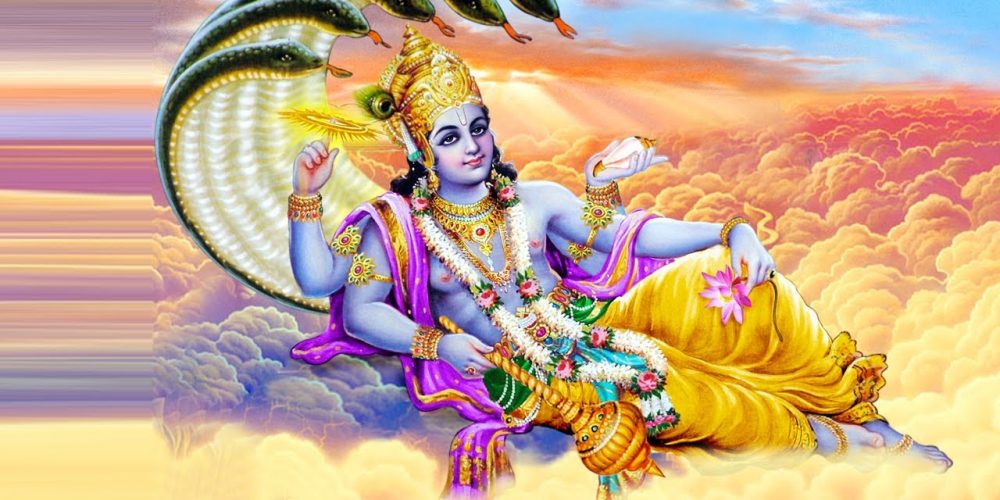The Sahasranāma is a popular genre in Stotra literature wherein a deity is remembered by a thousand epithets. The Viṣṇu Sahasranāma is without doubt the most famous of all Sahasranāmas. It is arguably one of the two most widely sung Sanskrit songs in India along with Veṅkaṭeśa Suprabhātam. A measure of its popularity is the number of YouTube views for the MS Subbulakshmi rendered version uploaded 24 months ago – 46 million averaging roughly 64,000 views per day.
However unlike Veṅkaṭeśa Suprabhātam, which is a 15th century composition, the Viṣṇu Sahasranāma is a very ancient stotra found in many texts including Mahābhārata, and several Purāṇas. The version that is most famous is the one found in Anuśāsana Parva, the 13th book of Mahābhārata, the great Itihāsa text.
The Anuśāsana Parva is the book in Mahabharata that succeeds the Śānti Parva. Like Śānti Parva, the thirteenth book also takes the form of a dialogue between Yudhiṣṭhira and Bhishma after the Great Kurukshetra War. The Viṣṇu Sahasranāma stotra features in the 149th chapter of Anuśāsana Parva. It begins with Yudhiṣṭhira posing the great Bhishma (who is lying on his bed of arrows) the question –
किमेकं दैवतं लोके किं वाप्येकं परायणम् ।
स्तुवन्तः कं कमर्चन्तः प्राप्नुयुर्मानवाः शुभम्
को धर्मः सर्वधर्माणां भवतः परमो मतः ।
किं जपन्मुच्यते जन्तुर्जन्मसंसारबन्धनात् ॥
“In this universe Who is the one refuge for all? Who is the greatest Lord in the world? By eulogising whom can a person reach auspiciousness? What is, in thy opinion, the Greatest Dharma of all Dharmas? By chanting whose name can a creature proceed beyond the bonds of samsāra?”
Bhishma responds by chanting the “Viṣṇu Sahasranāma” – the thousand names of the Supreme Godhead Vishnu, and advocates the chanting of the same to all mankind.
The Sahasranāma is in my view an early example of Bhakti literature, which describes with great elan the attributes of the supreme Brahman. The Supreme Being here is very much Saguṇa-Brahman (a Godhead with attributes).
Having said that the Sahasranāma has attracted commentaries from all schools of Vedanta including the Advaita School of Śaṅkara.
The three major traditional commentaries are –
- Ādi Śaṅkarāchārya’s Bhāṣya : 8th century (Advaita commentary)
- Parāśara Bhattar ‘s Bhāṣya : 12th century (Viśiṣṭādvaita commentary)
- Madhvāchārya ‘s Bhāṣya : 13th century (Dvaita commentary)
While Śaṅkara and Madhva are known to all, Parāśara Bhattar may be a less well-known name outside Śrī- Vaiśnava circles. He was the son of Koorathazhwan (Srivatsanka Mishra), a landlord of Kanchipuram and a very close associate of Sri Ramānuja. His Bhāṣya on the Viṣṇu Sahasranāma titled “Bhagavad Guṇa Darpaṇam” is widely regarded as his magnum opus.
In this essay we pick four names sung in the Sahasranāma, and examine the commentaries of Śaṅkara and Parāśara Bhattar on these names to understand how the Advaita and Viśiṣṭādvaita schools have interpreted the epithets. While Śaṅkara leans towards an interpretation of the names grounded in Śruti texts, Parāśara Bhattar chooses to focus on the etymology of the names to discern their meaning in a manner that celebrates the moral excellences of the Godhead.
So let’s look at the four names chosen for this piece –
- Vaṣaṭkāraḥ (Name #3)
- Avyayaḥ (Name #13)
- Śivaḥ (Name #27)
- Trivikramaḥ (Name #530)
For each of these names, the actual Bhāṣya text of both Ādi Śaṅkara and Parāśara Bhattar is reproduced followed by the English translation and some comments.
Vaṣaṭkāraḥ (Name #3)
Ādi Śaṅkara’s commentary
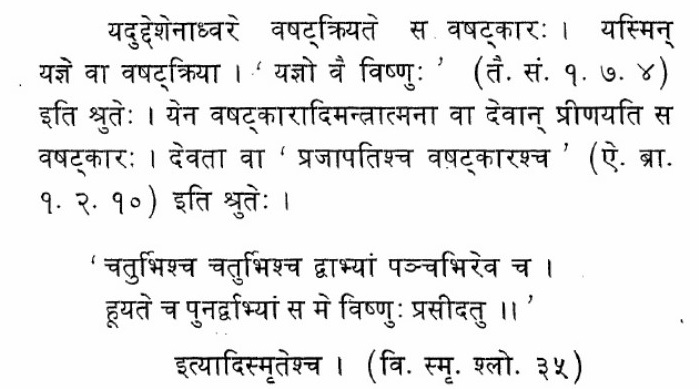 The above Bhāṣya provides several alternative meanings. As a literal translation can be hard to read, I am paraphrasing the Bhāṣya’s literal translation by R Ananthakrishna Sastry, to make it readable, as opposed to reproducing the literal translation by Mr Sastry as is. So here’s the paraphrased translation –
The above Bhāṣya provides several alternative meanings. As a literal translation can be hard to read, I am paraphrasing the Bhāṣya’s literal translation by R Ananthakrishna Sastry, to make it readable, as opposed to reproducing the literal translation by Mr Sastry as is. So here’s the paraphrased translation –
- Vaṣat is a technical word with which oblations are offered in fire to the gods
- He on whose account Vaṣaṭkāra is offered, or that sacrifice in which Vaṣaṭkāra is offered. The Śruti (Taittareya Samhita 1.7.4) says “Sacrifice, indeed, is Viṣṇu”
- He pleases the gods by himself being one with Vaṣaṭkāra and other mantras
- Aitareya Brāhmaṇa (1.2.10) says “Lord Prajapati and Vaṣaṭkāra” suggesting that Vaṣaṭkāra is a deity
- The Viṣṇu Smṛti (verse 35) says – “He who is invoked in sacrifices by such mantras as the four-syllabled A-śra-va-ya, the four-syllabled A-stu-śrau-sat, the two-syllabled Yaha, the five syllabled Ye-ya-jā-ma-he and the two-syllabled Vauṣat – let that Viṣṇu be pleased with me.
So clearly Ādi Śaṅkara is drawing on Śruti and Smṛti texts to suggest that Vaṣaṭkārah is strongly linked to the very act of Vedic sacrifice and he also draws on the Śruti literature to state that Viṣṇu is the Sacrifice Himself.
Now let’s look at Parāśara Bhattar’s take on the same name, which is a radically different interpretation.
Parāśara Bhattar’s commentary:
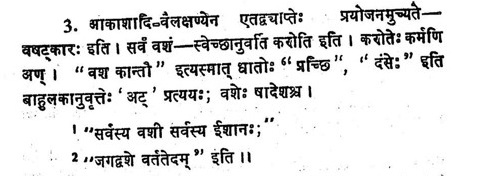 Here’s the paraphrased translation of the above Bhāṣya drawing on the literal translation by Prof A Srinivasa Raghavan
Here’s the paraphrased translation of the above Bhāṣya drawing on the literal translation by Prof A Srinivasa Raghavan
- Vaṣaṭkārah is one who controls and directs (not merely pervades)
- While Bhagavān pervades the universe exactly as “ether” (Akaśa) does, the pervasion by Bhagavān is different because he makes everyone act accordingly to His will (vaṣ)–
- The root “vas” means lustre to which the suffix “at” is added
- The Upaniśads declare Him to be the “Controller of all and Ruler of all” while it is also stated elsewhere that the “Universe is under his control”
So Parāśara Bhattar here is giving an altogether different interpretation by drawing on Upaniśads instead of Saṃhitā / Brāhmaṇa literature and also examining the word’s etymology. His interpretation is more in line with Vaiśnava Bhakti where the command and power of the Godhead is underlined which Śaṅkara chooses not to emphasize. A classic example of how the two Bhāṣyakārs have used different sources from the same Śruti / Smṛti corpus to back their respective philosophical inclinations
Avyayaḥ: Name #13
Ādi Śaṅkara’s commentary:
 Here’s the paraphrased translation –
Here’s the paraphrased translation –
- Avyaya means “indestructible”, “unchanging”.
- This meaning is backed by Bṛhadāranyaka Upaniśad (4.4.25) which says “He is undecaying, immortal, indestructible”
Śaṅkara’s Bhāṣya for this name is very precise and backed by a Śruti source.
Parāśara Bhattar’s commentary:
Now let’s contrast this with Parāśara Bhattar’s Bhāṣya reproduced below –
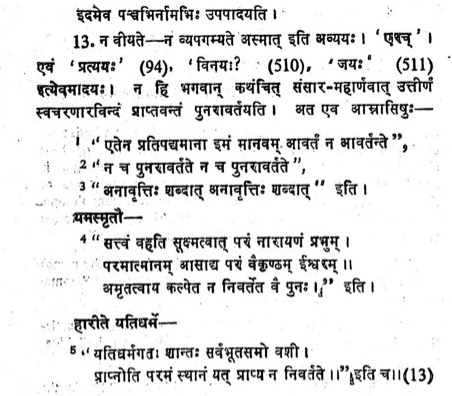 Here’s the paraphrased translation –
Here’s the paraphrased translation –
- Avyayaḥ refers to Him who does not send back any of the Muktas (souls who have crossed the vast ocean of Samsāra)
- The word is derived from the verb “na veeyate”. His name is Avyayaḥ since no one is sent back by him.
- Is it not a well known fact that Bhagavān never sends back the Ātma, who has by some means and effort, crossed the vast ocean of Samsāra and has reached his lotus feet.
- The Yama Smṛti says – “The Mukta bears a body of pure and subtle Sattva and attains the Supreme Lord who is the Paramā Then he becomes fit for immortality and does not come back to this world anymore.
- Hārita (dealing with Yati dharma – the code of Sanyāsins) says – “One who has taken the life of a Yati is calm and and equally disposed towards all beings and self-controlled. He attains the highest place in Vaikunta, and after reaching it never comes back.
Again Bhattar’s commentary here is very different from that of Śaṅkara. While the latter chooses to talk of the Godhead’s indestructibility, Parāśara Bhattar chooses a different etymological route for the word to emphasise the grace of the lord towards Muktas (great, liberated souls).
Śivaḥ: Name #27
Ādi Śaṅkara’s commentary
- He is “Pure”, being free from the three qualities (Sattva, Rajas, Tamas)
- Viṣṇu alone is praised by the name Śiva and other names
- As per Taittareya Āranyaka – “He is Brahman. He is Śiva”
So Śaṅkara is not associating Śivaḥ with Lord Mahādeva, but is instead positioning Viṣṇu as a Nirguṇa Brahman – the transcendental Supreme Being who is beyond the three Guṇas.
Parāśara Bhattar not surprisingly has a different take as we shall see
Parāśara Bhattar’s commentary:
Here’s the translation of Parāśara’s Bhāṣya –
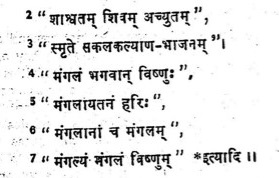
- He is “Śiva” as he confers auspiciousness on all.
- The word “Śiva” is derived from the root “Seeng” which signifies auspiciousness. The suffix “van” is added in accordance with a grammatical rule.
- He is “the Eternal, the auspicious, the never-deserting”
- When He is remembered, the devotee becomes the abode of auspiciousness.
- He is the cause of auspiciousness in all things that are auspicious.
- Viṣṇu is himself auspicious and is the object of our auspicious acts.
So Parāśara unlike Śaṅkara is positioning Viṣṇu clearly as one suffused with auspiciousness, and not necessarily free from the 3 Guṇas. It is a radically different take that is suffused very explicitly with Bhakti.
Now let’s look at one last name “Trivikramaḥ” where interestingly the two Bhāṣyakārs provide somewhat atypical commentaries.
Trivikramaḥ: Name #530
Ādi Śaṅkara’s commentary:
 Here’s the paraphrased translation –
Here’s the paraphrased translation –
- The name means the One “of three Steps”
- The three steps covered the three worlds
- He triumphed over the three worlds with the three steps, as per the Śruti (Taittareya Brahmana, 2.4.6)
- The Harivaṃśa in verse 69 says – “The sages have named the three worlds as “tri” and as You have covered them in three steps, You are named Trivikrama
So Śaṅkara here is clearly giving a Bhāṣya that is very much in line with our Purānic understanding of Viṣṇu as the conqueror of the three worlds. It is very much reminiscent of the Vāmana Avatār, which Śaṅkara was doubtless aware of. The notion of Viṣṇu striding the three worlds also occurs famously in the Ṛgveda– one of the oldest texts in the Hindu tradition
Parāśara Bhattar’s commentary
 Now here’s the paraphrased Bhāṣya from Parāśara –
Now here’s the paraphrased Bhāṣya from Parāśara –
- Trivikramaḥ means “He who traverses or pervades the three Vedas”
- By his greatness, Bhagavān pervades through the three Vedas as their main topic.
- “Triad” is the term by which the three Vedas are referred to by the sages. Thou traverses / pervades all three of them and hence Thou are known by the name Trivikrama.
- Trivikrama is the One in praise of whom Vedas speak in one voice.
- Narayana is the main topic dealt with by the Vedas.
This is fascinating, because contrary to our expectation, Parāśara is not giving the Puranic explanation for the name “Trivikrama” or even talking about the three strides. Given his penchant for delving into the etymology of words, one would have expected Parāśara to talk of the three strides of Viṣṇu. But instead he chooses to associate the Triad here with the three Vedas, rather than the three steps of Purānic and Vedic lore.
Conclusion
Reading the Viṣṇu Sahasranāma is a rewarding experience especially when it is done in the company of Bhāṣyakārs as distinguished as Śaṅkara and Parāśara Bhattar. Their mastery of primary sources to explain seemingly facile names in novel ways never ceases to fascinate us. However we are also equally fascinated by their differences of opinion and their vastly different philosophical vantage points which prompt them to arrive at completely different interpretations for the same names as we have noted above.
One is also impressed by the fact that the Sahasranāma is not just a very great Bhakti text, but also a Sanskritist’s delight. There are not many better ways of learning the etymology of Sanskrit words than to get started on reading the Bhāṣyas on the Viṣṇu Sahasranāma.
References
- Viṣṇu Sahasranāma with the Bhāṣya of Ādi Śaṅkarāchārya – Translation by R Anantha Krishna Sastry
- Bhagavad Guṇa Darpaṇam by Parāśara Bhattar – Translation by Prof A Srinivasa Raghavan
Featured Image: Malbar.fr
Disclaimer: The opinions expressed within this article are the personal opinions of the author. IndiaFacts does not assume any responsibility or liability for the accuracy, completeness, suitability, or validity of any information in this article.
Shrikanth Krishnamachary is a data scientist in financial services based out of New York City, whose interests include economics, political philosophy, Hinduism, American history, and cricket.

